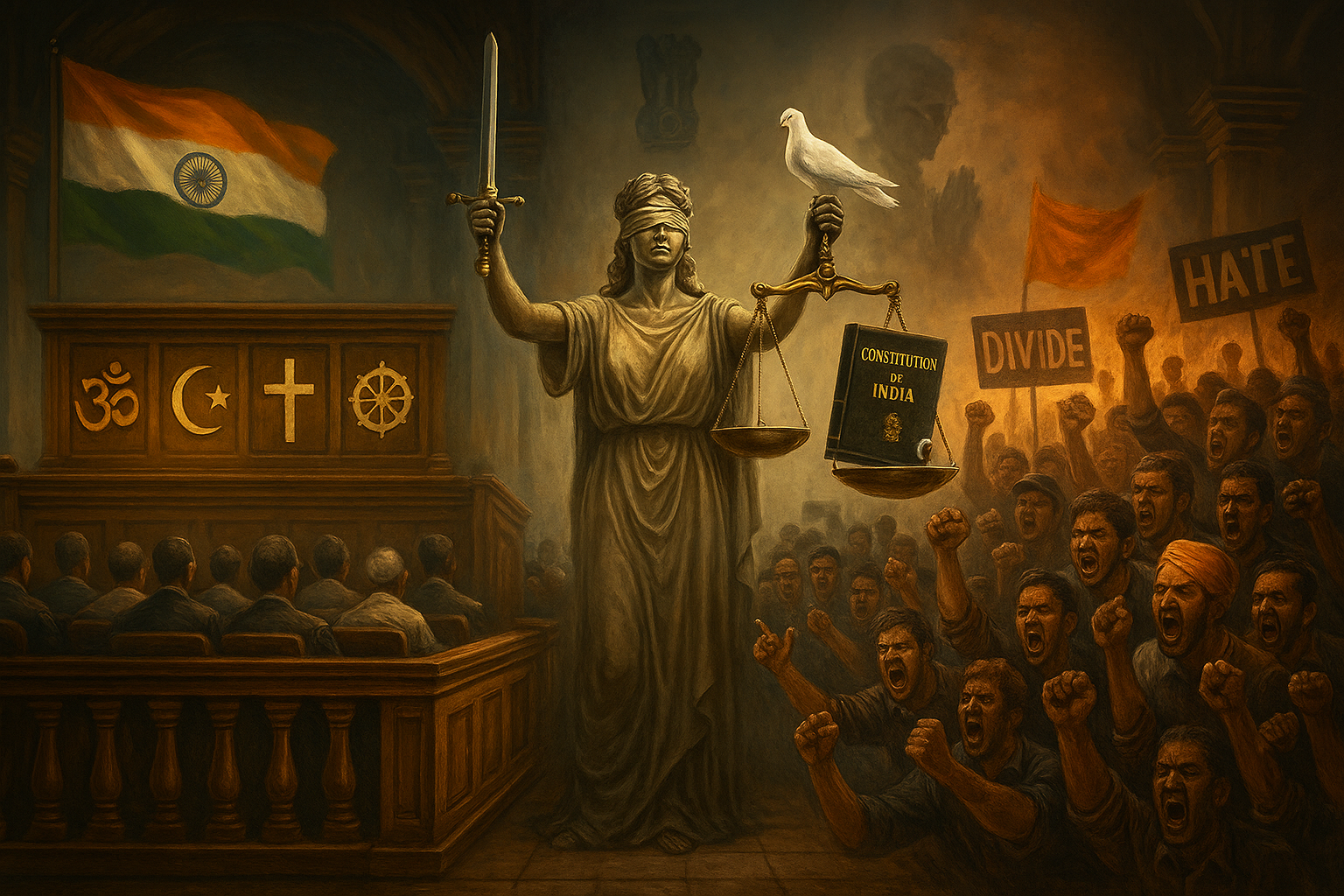SECULARISM
📅 Last updated: July 14, 2025 2 min read
 Why in News?
Why in News?
- Secularism is once again at the heart of national discourse, as debates grow over its interpretation and relevance in today’s India.
- While it was constitutionally formalized in 1976, many are revisiting its deeper roots—from Ashoka’s edicts to the freedom movement—to understand what it truly stands for.
- At a time when the line between religion and state seems increasingly blurred, there is a renewed call to uphold secularism as a guarantee of democracy, unity, and religious freedom.
 Why in News?
Why in News?
- Secularism is once again at the heart of national discourse, as debates grow over its interpretation and relevance in today’s India.
- While it was constitutionally formalized in 1976, many are revisiting its deeper roots—from Ashoka’s edicts to the freedom movement—to understand what it truly stands for.
- At a time when the line between religion and state seems increasingly blurred, there is a renewed call to uphold secularism as a guarantee of democracy, unity, and religious freedom.

Introduction
- Secularism as a Native Value: Unlike in the West, secularism in India emerged organically through its civilisational heritage. It reflects a unique tradition of accommodating diverse religious and philosophical beliefs within a single cultural framework.
- Example: Emperor Ashoka’s edicts carved on stone pillars across India called for religious harmony, and Mahatma Gandhi’s belief in ‘Sarva Dharma Sambhava’ promoted respect for all faiths.
Historical Roots of Indian Secularism
- Ashokan Edicts: The 12th Rock Edict specifically urged tolerance among different religious sects, making Ashoka a symbol of early secular governance in India.
- Bhakti & Sufi Movements: These spiritual revolutions dismissed rigid orthodoxy and brought people together through songs of divine love, transcending religious boundaries.
- Mughal Tolerance: Akbar’s doctrine of 'Sulh-i-Kul' (peace with all) ensured that the empire treated every community fairly, without religious discrimination.
- Freedom Movement Ideals: During the national struggle, leaders envisioned India as a land where religion would not dictate governance.
- Motilal Nehru Report: It explicitly stated that India would not have a state religion—an early commitment to secularism.
- Gandhi's Philosophy: He united Indians through spiritual pluralism, not religious dominance.
- Nehru and Ambedkar: Nehru supported scientific temper, while Ambedkar insisted on constitutional morality over religious dogma.
Philosophy of Indian Secularism
- Positive Secularism: Unlike Western secularism that calls for a total separation of religion and state, Indian secularism enables respectful engagement with all religions to ensure justice and equity.
- “Sarva Dharma Sambhava”: This principle emphasizes equal respect for all faiths, allowing them space in public life while maintaining state neutrality in religious matters.
- State Intervention for Social Justice: The state can intervene to reform practices that go against constitutional values—like banning Sati or criminalizing triple talaq—to balance religious freedom with human rights.
Constitutional Safeguards for Secularism
- Preamble: The term "Secular" was formally introduced in the Constitution by the 42nd Amendment in 1976, but its essence has been present since inception.
- Fundamental Rights Ensuring Equality:
- Article 14: Guarantees equality before law, regardless of faith.
- Articles 15 & 16: Prohibit discrimination in public places and jobs based on religion or caste.
- Articles 25–28: Provide freedom to practice, profess, and propagate any religion.
- Article 30: Grants minorities the right to manage their own educational institutions.
- Civic Duty: Article 51A encourages all citizens to promote religious harmony and protect India's composite culture.
- Basic Structure Doctrine: The Supreme Court, in the landmark Kesavananda Bharati case (1973), ruled that secularism is part of the Constitution’s basic structure, and cannot be altered even by Parliament.
Indian vs Western Model of Secularism
- Relational Difference: India actively engages with all religions, while the Western model avoids any formal connection between religion and state affairs.
- Religious Funding: India allows funding and aid to religious schools and pilgrimages (e.g., Haj, Amarnath Yatra), whereas most Western democracies ban this entirely.
- State Intervention: Indian secularism allows legal reforms to abolish religious practices that violate constitutional rights, such as Sati or instant divorce (Triple Talaq).
- Core Philosophy: India's 'positive secularism' emphasizes religious diversity and coexistence, while the West's 'negative secularism' promotes religious invisibility in public life.
Duality and Challenges in Indian Secularism
- Temple vs Church-Mosque Management: Hindu temples are often managed by government boards, whereas religious institutions of other faiths enjoy more autonomy—raising concerns of partiality.
- Educational Bias: Minority-run schools have special rights under Article 30 and are exempted from some regulations like the RTE Act, creating inequality for Hindu-run institutions.
- Caste-Based Disparity in Reservations: Dalit Christians and Muslims are excluded from SC quotas, although they suffer similar social discrimination as their Hindu counterparts.
- Selective Secularism in Politics: Political parties often use religion to either appease minorities or polarize majorities, compromising secular ideals.
Threats to Secularism
- Communal Violence: Clashes like the Delhi Riots (2020) expose the fragile nature of communal harmony and the misuse of religion for political provocation.
- Mob Lynching: The rise in mob violence over religious identity—such as cow-related lynchings—destabilizes the secular fabric.
- Religious Radicalization: Extremism from both majorities and minorities, often amplified through social media, promotes hatred and fear.
- Vote-Bank Politics: Religious groups are often courted for votes with promises of protection or privilege, diluting the principle of equal treatment.
Way Forward
- Promote Value-Based Education: Schools should include curricula on ethical living, diversity appreciation, and interfaith understanding to nurture a tolerant generation.
- Implement Uniform Civil Code: A common set of personal laws for all citizens—irrespective of religion—will promote true equality and reduce legal discrimination.
- End Legal and Institutional Bias: All religious institutions and communities must be treated fairly under the same laws, ending special privileges or disadvantages.
- Strengthen Institutional Independence: Key institutions like the judiciary and police must be shielded from religious and political pressure to uphold constitutional values.
Conclusion
- India’s Indigenous Secularism: Secularism in India is not imported—it reflects the historical and spiritual maturity of a civilization that has always embraced diversity.
- Need for Reinvigoration: Instead of abandoning secularism due to its flaws, we must correct and revive it to meet the aspirations of a modern pluralistic democracy.
- Existential Imperative: In a deeply diverse country like India, secularism is not a policy choice—it is a necessity for peace, unity, and national survival.
Introduction
- Secularism as a Native Value: Unlike in the West, secularism in India emerged organically through its civilisational heritage. It reflects a unique tradition of accommodating diverse religious and philosophical beliefs within a single cultural framework.
- Example: Emperor Ashoka’s edicts carved on stone pillars across India called for religious harmony, and Mahatma Gandhi’s belief in ‘Sarva Dharma Sambhava’ promoted respect for all faiths.
Historical Roots of Indian Secularism
- Ashokan Edicts: The 12th Rock Edict specifically urged tolerance among different religious sects, making Ashoka a symbol of early secular governance in India.
- Bhakti & Sufi Movements: These spiritual revolutions dismissed rigid orthodoxy and brought people together through songs of divine love, transcending religious boundaries.
- Mughal Tolerance: Akbar’s doctrine of 'Sulh-i-Kul' (peace with all) ensured that the empire treated every community fairly, without religious discrimination.
- Freedom Movement Ideals: During the national struggle, leaders envisioned India as a land where religion would not dictate governance.
- Motilal Nehru Report: It explicitly stated that India would not have a state religion—an early commitment to secularism.
- Gandhi's Philosophy: He united Indians through spiritual pluralism, not religious dominance.
- Nehru and Ambedkar: Nehru supported scientific temper, while Ambedkar insisted on constitutional morality over religious dogma.
Philosophy of Indian Secularism
- Positive Secularism: Unlike Western secularism that calls for a total separation of religion and state, Indian secularism enables respectful engagement with all religions to ensure justice and equity.
- “Sarva Dharma Sambhava”: This principle emphasizes equal respect for all faiths, allowing them space in public life while maintaining state neutrality in religious matters.
- State Intervention for Social Justice: The state can intervene to reform practices that go against constitutional values—like banning Sati or criminalizing triple talaq—to balance religious freedom with human rights.
Constitutional Safeguards for Secularism
- Preamble: The term "Secular" was formally introduced in the Constitution by the 42nd Amendment in 1976, but its essence has been present since inception.
- Fundamental Rights Ensuring Equality:
- Article 14: Guarantees equality before law, regardless of faith.
- Articles 15 & 16: Prohibit discrimination in public places and jobs based on religion or caste.
- Articles 25–28: Provide freedom to practice, profess, and propagate any religion.
- Article 30: Grants minorities the right to manage their own educational institutions.
- Civic Duty: Article 51A encourages all citizens to promote religious harmony and protect India's composite culture.
- Basic Structure Doctrine: The Supreme Court, in the landmark Kesavananda Bharati case (1973), ruled that secularism is part of the Constitution’s basic structure, and cannot be altered even by Parliament.
Indian vs Western Model of Secularism
- Relational Difference: India actively engages with all religions, while the Western model avoids any formal connection between religion and state affairs.
- Religious Funding: India allows funding and aid to religious schools and pilgrimages (e.g., Haj, Amarnath Yatra), whereas most Western democracies ban this entirely.
- State Intervention: Indian secularism allows legal reforms to abolish religious practices that violate constitutional rights, such as Sati or instant divorce (Triple Talaq).
- Core Philosophy: India's 'positive secularism' emphasizes religious diversity and coexistence, while the West's 'negative secularism' promotes religious invisibility in public life.
Duality and Challenges in Indian Secularism
- Temple vs Church-Mosque Management: Hindu temples are often managed by government boards, whereas religious institutions of other faiths enjoy more autonomy—raising concerns of partiality.
- Educational Bias: Minority-run schools have special rights under Article 30 and are exempted from some regulations like the RTE Act, creating inequality for Hindu-run institutions.
- Caste-Based Disparity in Reservations: Dalit Christians and Muslims are excluded from SC quotas, although they suffer similar social discrimination as their Hindu counterparts.
- Selective Secularism in Politics: Political parties often use religion to either appease minorities or polarize majorities, compromising secular ideals.
Threats to Secularism
- Communal Violence: Clashes like the Delhi Riots (2020) expose the fragile nature of communal harmony and the misuse of religion for political provocation.
- Mob Lynching: The rise in mob violence over religious identity—such as cow-related lynchings—destabilizes the secular fabric.
- Religious Radicalization: Extremism from both majorities and minorities, often amplified through social media, promotes hatred and fear.
- Vote-Bank Politics: Religious groups are often courted for votes with promises of protection or privilege, diluting the principle of equal treatment.
Way Forward
- Promote Value-Based Education: Schools should include curricula on ethical living, diversity appreciation, and interfaith understanding to nurture a tolerant generation.
- Implement Uniform Civil Code: A common set of personal laws for all citizens—irrespective of religion—will promote true equality and reduce legal discrimination.
- End Legal and Institutional Bias: All religious institutions and communities must be treated fairly under the same laws, ending special privileges or disadvantages.
- Strengthen Institutional Independence: Key institutions like the judiciary and police must be shielded from religious and political pressure to uphold constitutional values.
Conclusion
- India’s Indigenous Secularism: Secularism in India is not imported—it reflects the historical and spiritual maturity of a civilization that has always embraced diversity.
- Need for Reinvigoration: Instead of abandoning secularism due to its flaws, we must correct and revive it to meet the aspirations of a modern pluralistic democracy.
- Existential Imperative: In a deeply diverse country like India, secularism is not a policy choice—it is a necessity for peace, unity, and national survival.


